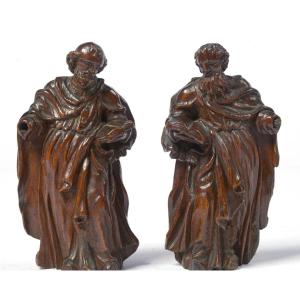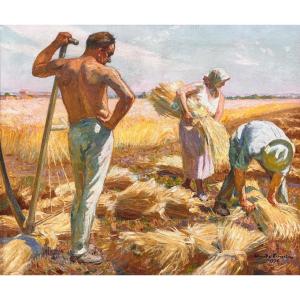Scenes of gallantry
(2) Oil on board, cm 24 x 19
With frame, cm 44 x 36
This pair of works ascribable to the artistic context of the eighteenth century French celebrates the theme of courteous love and sensual pleasure, typical of Rococo painting: are in fact represented two scenes of courtship that strictly follow the parameters of the rituals of the ancient courts. The festive and fun atmosphere that transpired from the two paintings perfectly reflects the carefree and refined lifestyle of the aristocracy that gravitated around the main European courts in the eighteenth century. The attention to detail, such as precious fabrics, jewelry and ornaments of extreme quality, emphasizes the luxury and refinement of court life, in line with the taste and aesthetics of French rococo. The two works in question fall fully within the pictorial genre, purely eighteenth-century, of the gallant scene. This current was radically opposite to the imposing and solemn classicism of the previous century, and wanted to communicate an indisputable sense of voluptuousness, frivolity and ineluctable decadence, in a kind of lost paradise. By now the nobility, almost totally deprived of the power that belonged to him until the seventeenth century, with its lavish feasts tried in vain to demonstrate their apparent wealth in these paintings, voice of the spirit of the time. This current of painting, which, around the middle of the century enjoyed an immense fortune, was swept away by the events that followed the French Revolution. In these two small gallant scenes, the influence of the activities of the key figures of 18th-century art in France, Watteau and Boucher, is strongly felt.Jean-Antoine Watteau was one of the initiators of the rococo style in French land, with its scenes of gallant parties and its wonderful bucolic landscapes populated by mythical characters or by a courteous audience who loves life and its pleasures. Influenced by Rubens and the works of the early eighteenth century of the flourishing Venetian school, with particular reference to the production tiepolesca, the French artist prefers the use of a colorful palette, expressive and vibrant, as well as the use of fast brushstrokes. Close to the teachings of Watteau is also François Boucher, who has been more dedicated to the perfection of perspective, learned from the baroque masters, and to the search for a lively colorism, borrowed from the models, perceived as absolutely illustrious, of Rubens and Correggio. The courtly and gallant scenes of the French artist have a bucolic and pastoral air, which seems to be perceptible also in these two paintings, mirror of the French artistic climate of the second half of the eighteenth century.








































 Le Magazine de PROANTIC
Le Magazine de PROANTIC TRÉSORS Magazine
TRÉSORS Magazine Rivista Artiquariato
Rivista Artiquariato